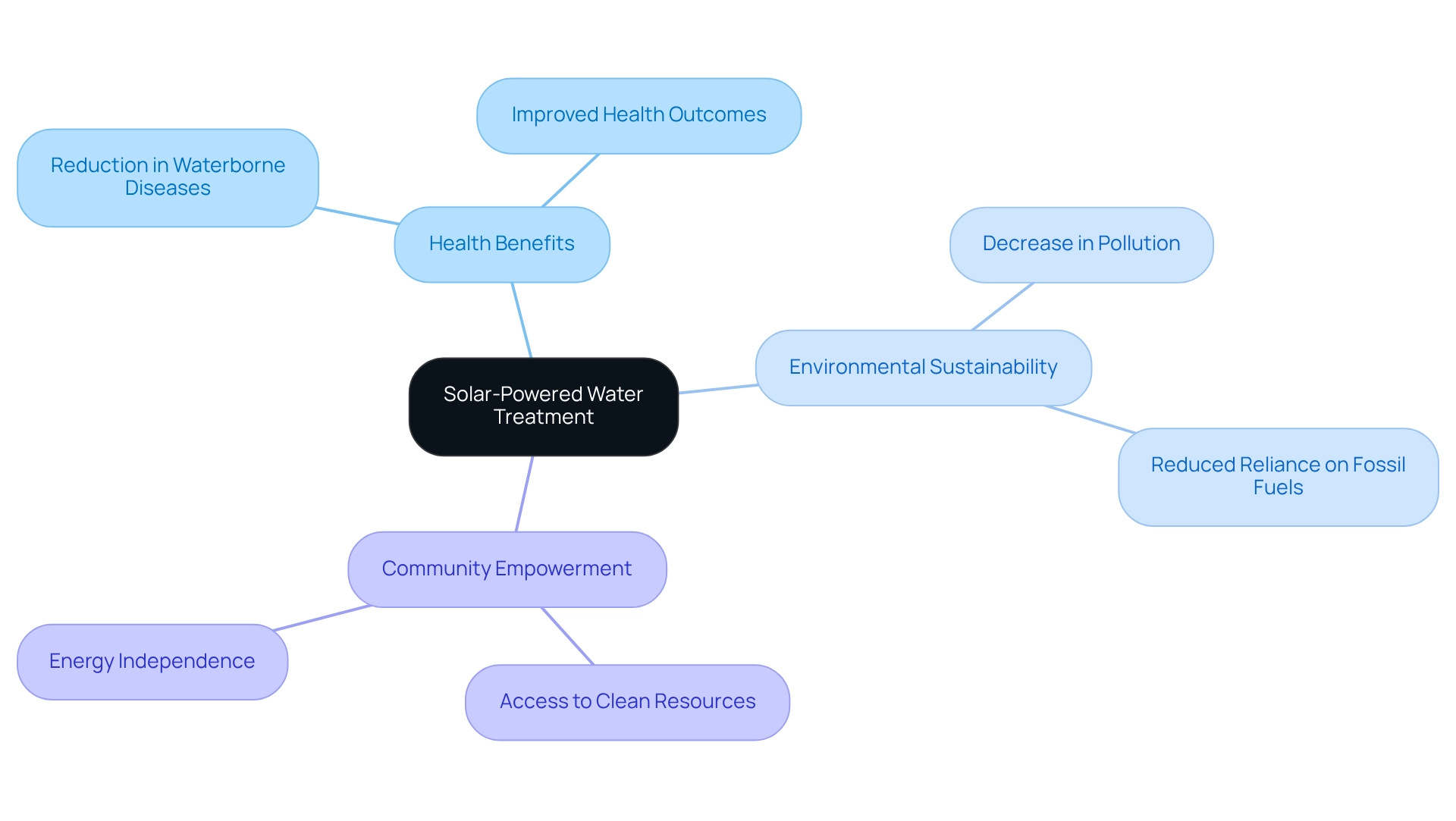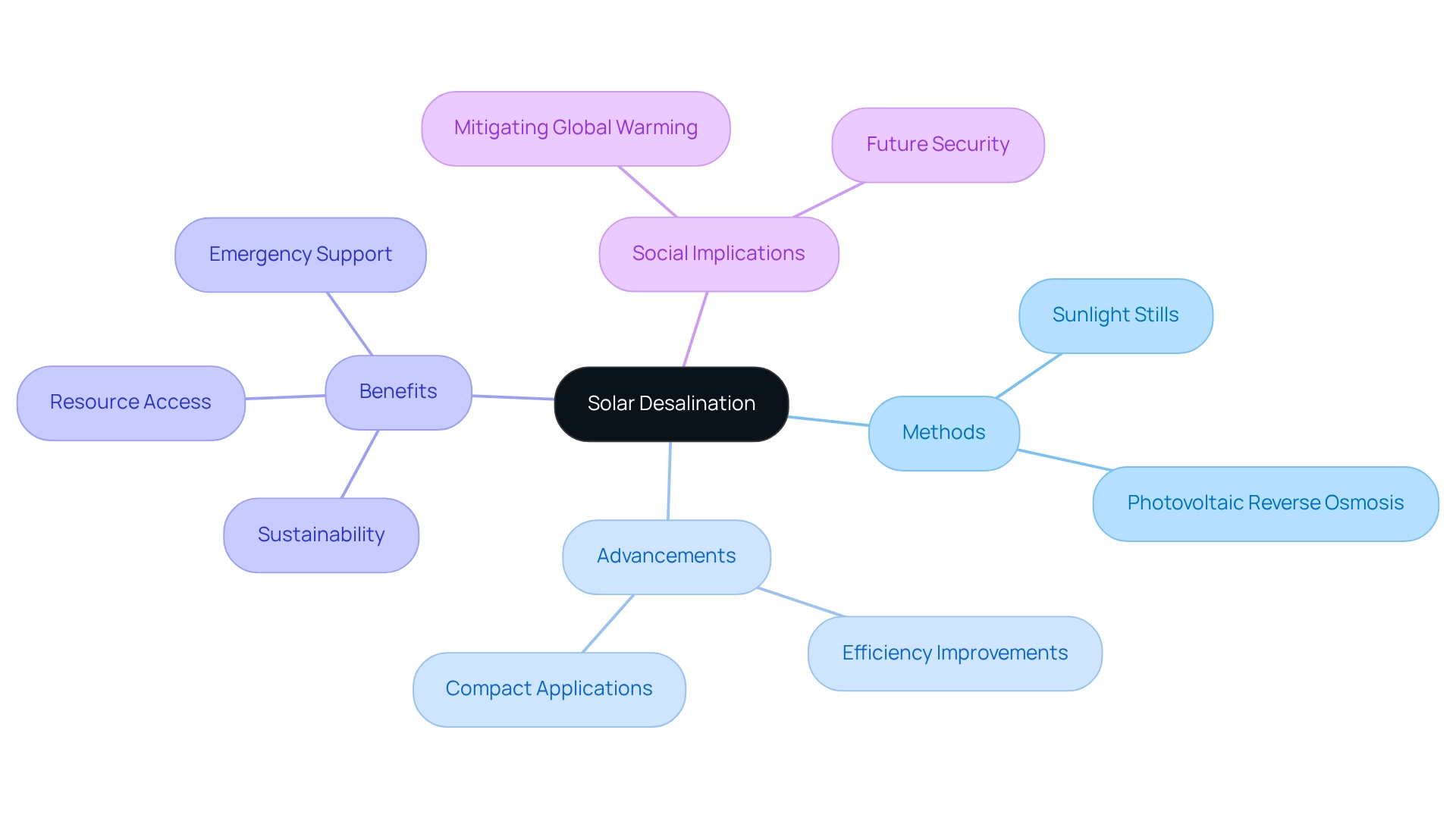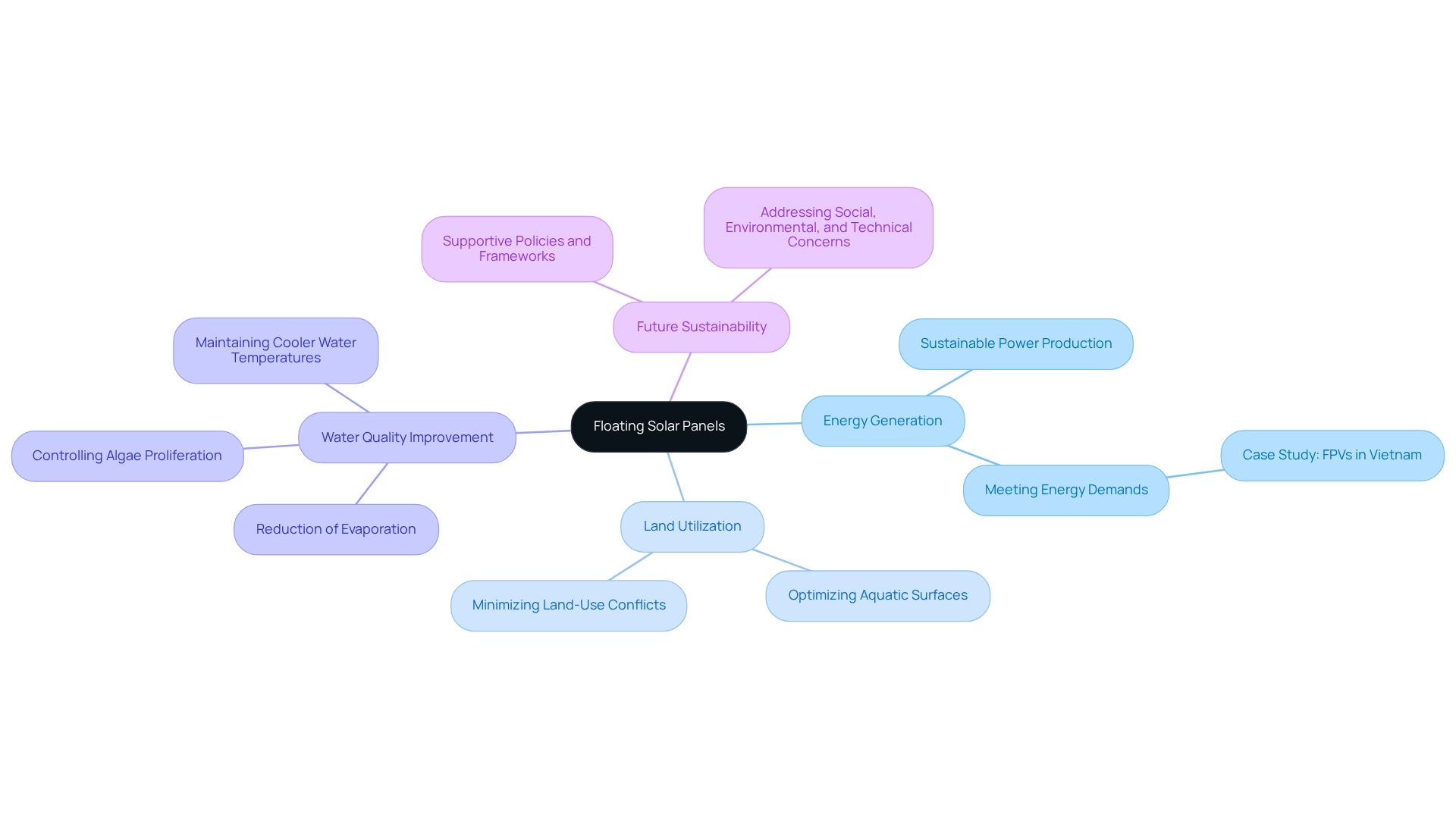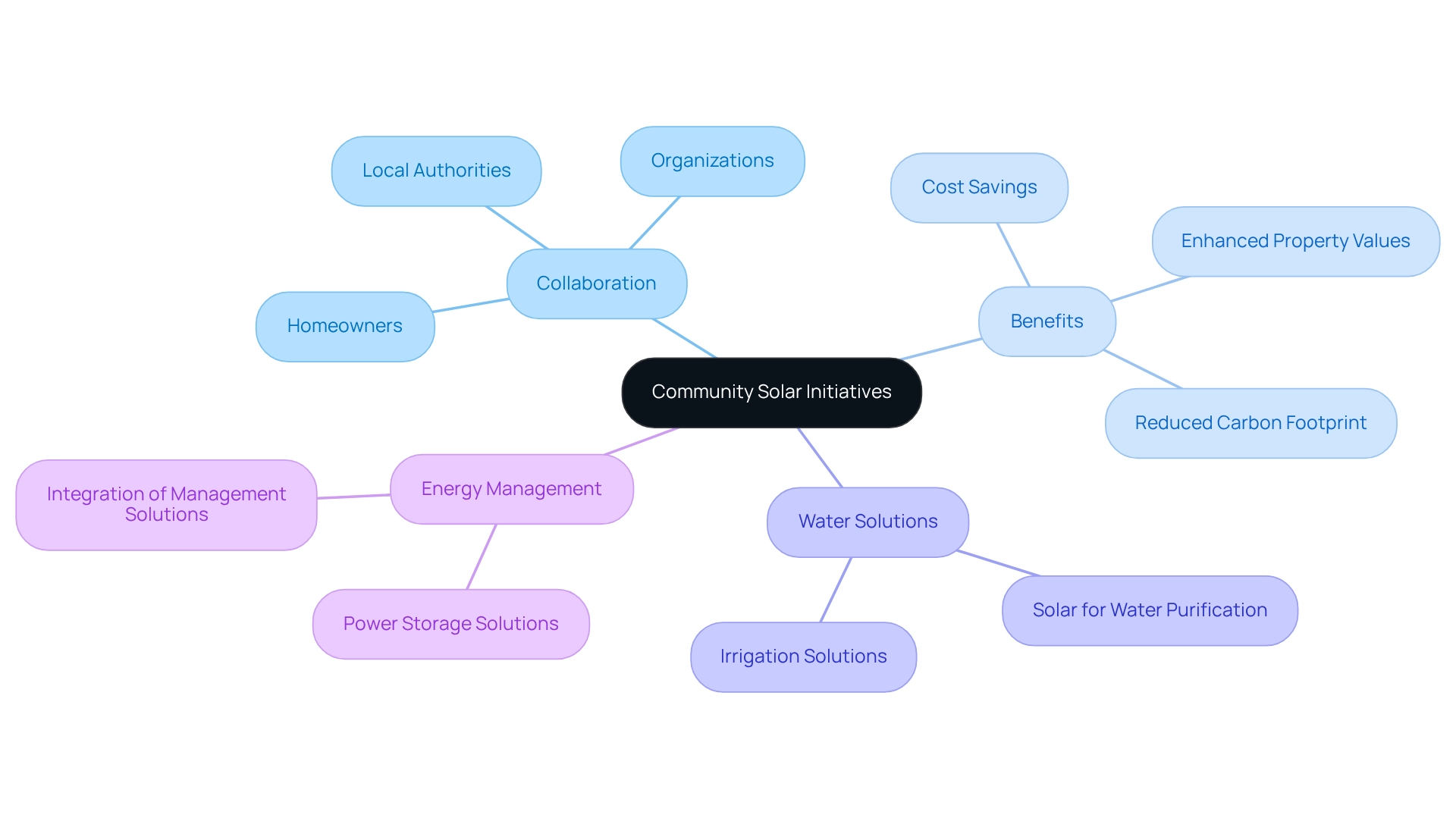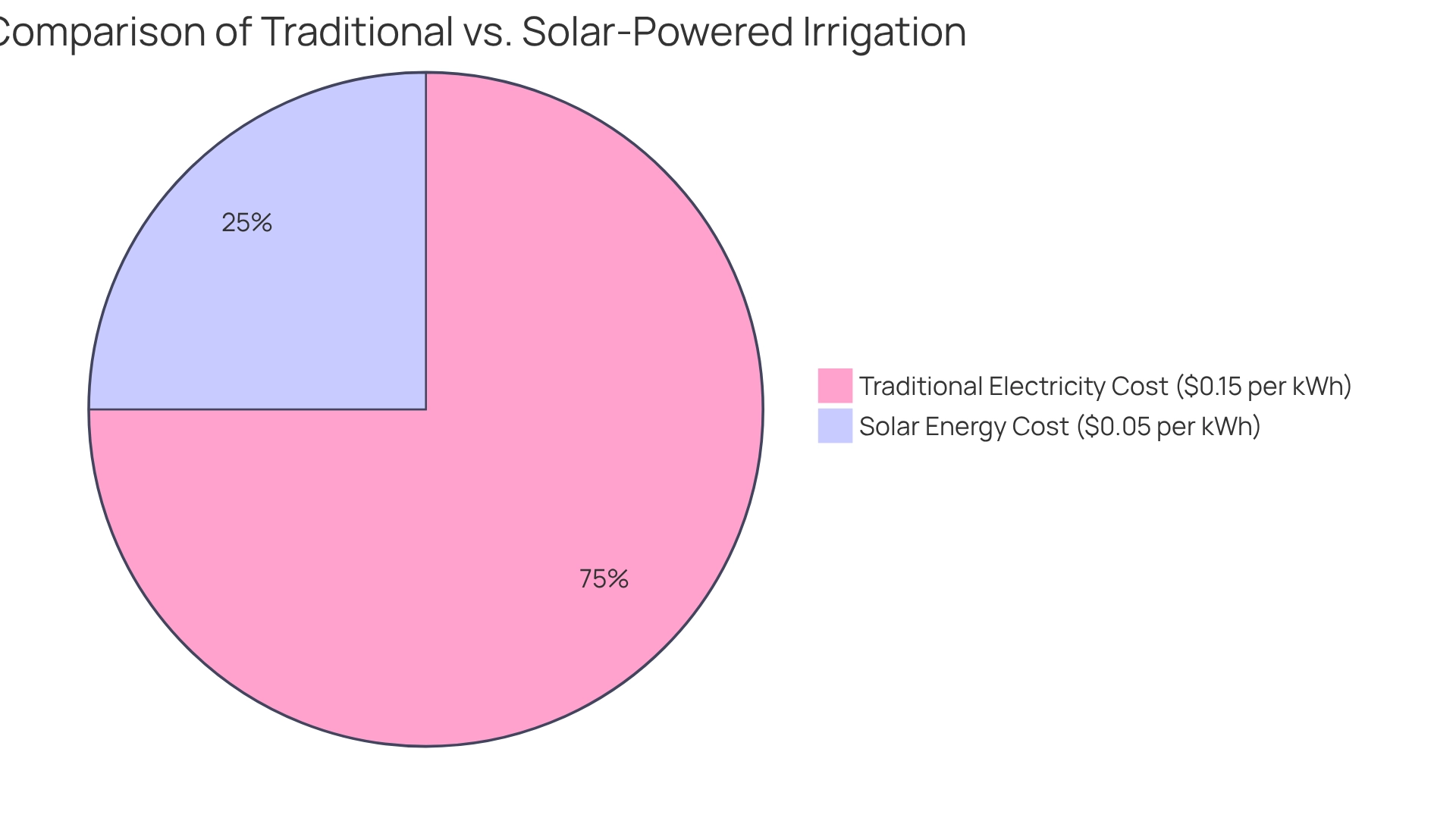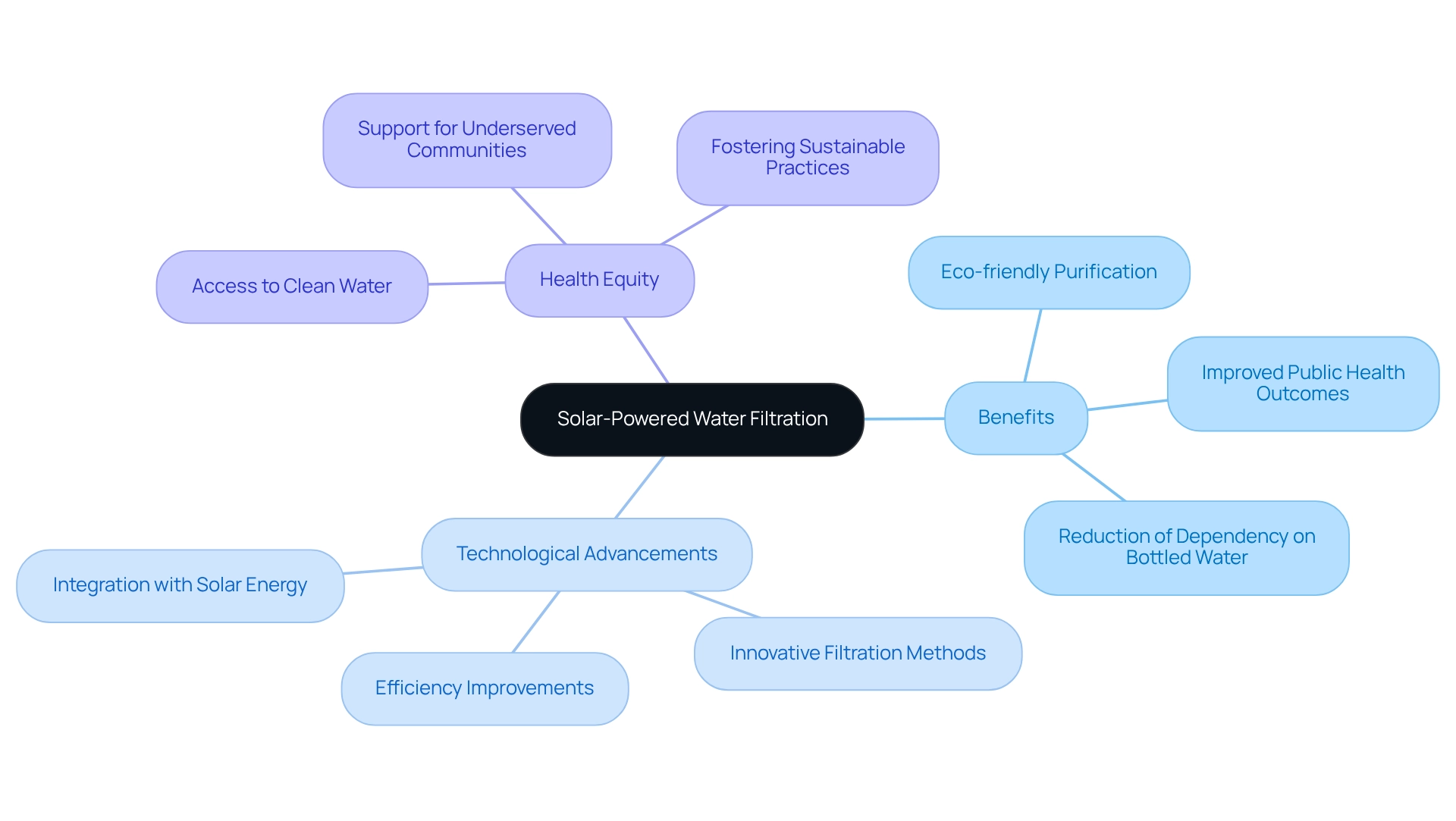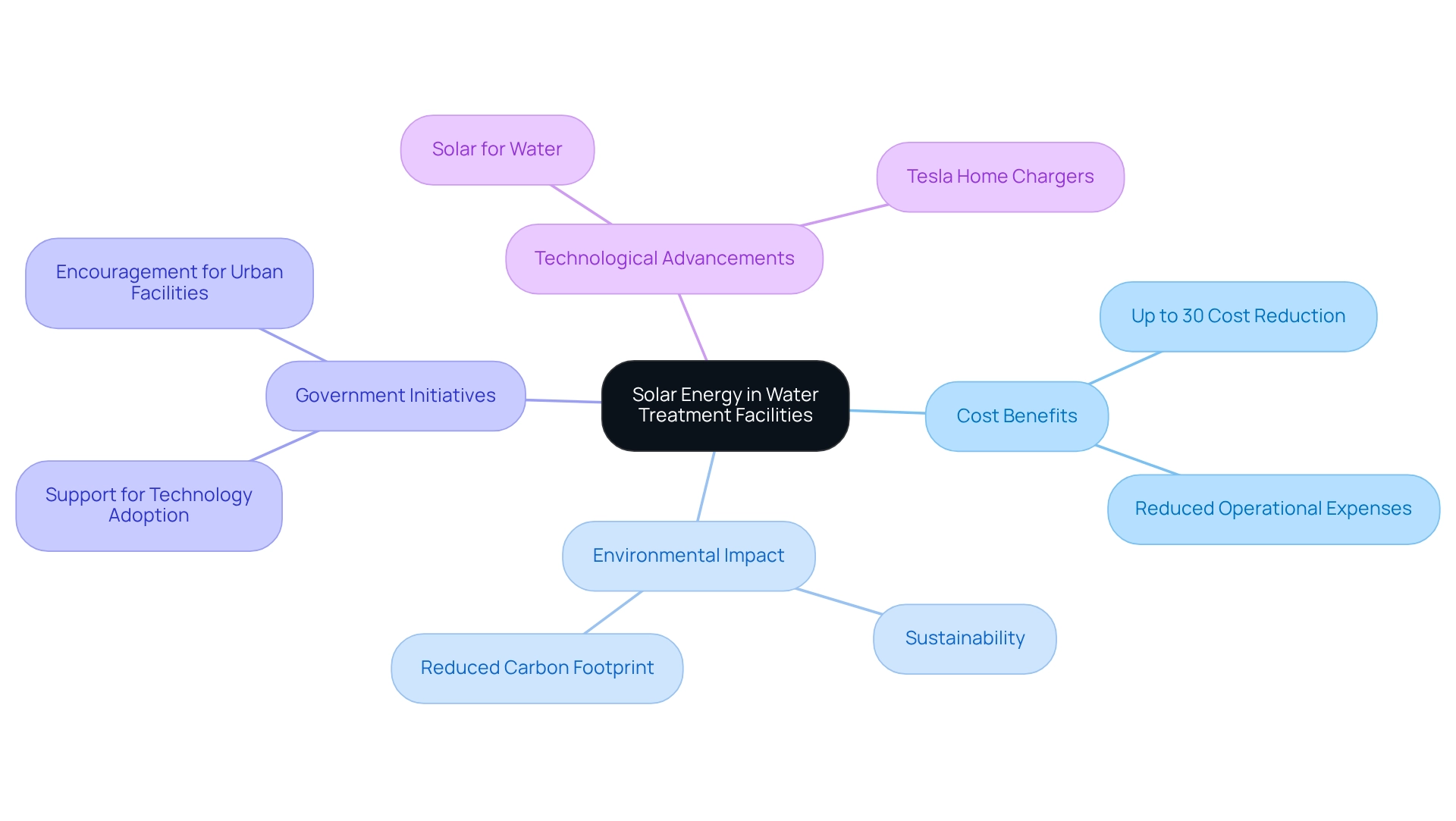Overview
The article emphasizes the transformative potential of solar technology for communities and agriculture, addressing the pressing concerns many have about rising energy bills. By offering sustainable solutions for water purification, irrigation, and overall resource management, it provides a pathway for a brighter future.
Imagine how solar-powered water filtration and irrigation systems can enhance access to clean water. Not only do these innovations reduce energy costs, but they also improve agricultural productivity, fostering healthier and more resilient communities. Together, we can work towards a sustainable future that meets our needs and nurtures our environment.
Introduction
In a world increasingly challenged by water scarcity and environmental concerns, we understand that accessing clean water can feel overwhelming. Innovative solutions are emerging to tackle these pressing issues, and it’s heartening to see the integration of solar technology into water purification and management systems. This revolution is transforming how communities can access clean water while promoting sustainability.
From solar-powered water filtration to desalination methods that convert seawater into drinking water, these advancements not only enhance public health but also mitigate the impacts of climate change. As the global demand for clean water continues to rise, exploring the potential of solar energy in water treatment becomes essential for ensuring a sustainable future.
Together, we can delve into the transformative role of solar solutions in addressing water challenges, highlighting their benefits for communities, agriculture, and urban infrastructure. Let’s work towards a future where everyone has access to the clean water they deserve.
Powercore Electric: Pioneering Solar Solutions for Water Purification
We understand that rising energy bills can be a significant concern for homeowners. Powercore Electric is leading the way in integrating solar for water purification solutions, utilizing cutting-edge photovoltaic panels and innovative storage alternatives. This approach not only enhances the effectiveness of treatment methods but also nurtures a sustainable future. By reducing dependence on traditional power sources, we can improve access to clean resources in communities, particularly those facing scarcity, and the role of solar for water in liquid purification systems is becoming increasingly evident as we approach 2025. Successful applications of solar for water showcase its efficiency in boosting water availability and quality.
Recent advancements in solar technology, such as enhanced photovoltaic efficiency and , have optimized these systems, making solar for water treatment environmentally friendly and economically viable. This not only aids in long-term climate change reduction but also supports your local environment. Local energy companies in Stockton, California, are stepping up by offering customized solutions tailored to the unique needs of . Together, we can enhance community health and promote sustainability.
For homeowners contemplating renewable energy options, it’s essential to evaluate the best solar panels for overcast days. Focus on specifications like efficiency ratings and warranty terms to ensure optimal performance in varying weather conditions. Let’s work towards a brighter, more sustainable future—one where you can enjoy energy independence and peace of mind.
Solar-Powered Water Treatment: Enhancing Community Health and Sustainability
We understand that many communities are concerned about access to clean resources and the impact of rising energy bills. Units that utilize solar for water purification emerge as a vital solution, offering dependable access to clean water while alleviating these worries. By harnessing solar for water filtration and purification, these systems significantly reduce our reliance on harmful chemicals and fossil fuels. This shift not only leads to a marked decrease in waterborne diseases but also fosters improved health outcomes for communities.
Imagine a future where your community thrives, free from the burden of pollution and illness. The sustainability of solar for water solutions addresses not only urgent health issues but also offers long-term ecological benefits. As we embrace these innovative technologies, on public health and environmental sustainability becomes increasingly evident. Together, we can create a healthier environment for ourselves and future generations.
As more communities adopt these solutions, we invite you to reflect on your energy habits. How can you contribute to this change? By choosing solar, you are not only making a responsible choice for your health but also joining a movement towards energy independence. Let’s work together to foster a sustainable future, where clean resources are accessible to all.
Solar Desalination: Addressing Water Scarcity in Arid Communities
In a world where over 2 billion people face resource scarcity, it’s common to feel concern about access to essential resources like water. are essential for arid communities as they utilize solar for water to convert seawater into drinkable liquid, addressing severe shortages.
By employing innovative methods such as solar for water through sunlight stills and photovoltaic reverse osmosis, these solutions not only provide a sustainable and economical approach to fresh water production but also alleviate the pressing scarcity of liquid resources. Imagine the relief that comes with knowing that communities can thrive despite environmental challenges.
Recent advancements in desalination technology have introduced more efficient methods that optimize energy use and reduce operational expenses. For instance, direct solar desalination technologies, like those developed by NEWT, are designed for compact applications, making them ideal for humanitarian efforts and rural resource management.
These systems hold the promise of dramatically enhancing access to this vital resource for millions, particularly in remote areas and during emergencies, with solar for water playing a crucial role. By utilizing renewable resources, solar desalination not only addresses urgent needs but also supports long-term sustainability in arid communities. Together, we can work towards a more resilient future.
Specialists observe that incorporating solar for water in tackling resource scarcity is a hopeful advancement toward reducing global warming and ensuring a sustainable future. Let’s embrace these innovative solutions that not only provide immediate relief but also foster a sense of security and hope for generations to come.
Solar Water Pumps: Revolutionizing Agriculture and Food Security
Are you concerned about rising energy bills? Solar for water is set to transform your agricultural practices by providing a dependable and sustainable source of irrigation through solar irrigation pumps. These groundbreaking technologies harness solar for water to draw liquid from wells or surface sources, allowing you to irrigate your crops without the burden of expensive fossil fuels or grid electricity. This shift not only reduces operational costs but also significantly enhances food security through more consistent and efficient resource utilization. As a result, you can increase your yields and diversify your crops, which in turn strengthens local economies and food networks.
At Powercore Electric, we understand the importance of energy independence. Our advanced energy solutions not only lower operational expenses but also improve food security by enabling more consistent and efficient solar for water usage. With our professional assistance, you can boost your production and expand your crop variety, benefiting while enjoying assured savings on utility expenses. Our Best Pricing Guarantee ensures that you receive the most cost-effective energy solutions tailored to your needs.
But don’t just take our word for it. Testimonials from satisfied customers highlight the effectiveness of our systems:
“We saved over 30% on our energy bills within the first year! Powercore’s team made the process easy and affordable.” – Jane D., Satisfied Customer.
Are you ready to take the next step towards transforming your agricultural practices? Together, let’s work towards a sustainable future. Obtain your complimentary, customized estimate from Powercore Electric today and discover how our pumping systems can enhance your agricultural activities.
Floating Solar Panels: Maximizing Land Use and Improving Water Quality
We understand that many homeowners are concerned about rising energy bills and the impact of traditional energy sources on our planet. Floating photovoltaic panels represent a groundbreaking method to optimize land utilization by placing energy arrays on aquatic surfaces, such as lakes and reservoirs. This innovative solution not only produces sustainable power but also incorporates solar for water, playing a vital role in improving water quality. By decreasing evaporation and controlling algae proliferation, floating photovoltaic panels help maintain cooler water temperatures, which is beneficial for aquatic ecosystems. This dual-use strategy is especially advantageous in regions where land is limited, allowing for sustainable power generation without compromising agricultural or natural landscapes.
It’s common to feel overwhelmed by energy needs, but floating renewable energy technology has shown notable efficiency by utilizing otherwise underutilized aquatic surfaces. For instance, the case study titled ‘FPVs in Vietnam: Addressing Energy Needs’ illustrates how floating photovoltaic systems can assist Vietnam in meeting its increasing power requirements while minimizing land-use conflicts. By efficiently utilizing solar for water in , we can create a more sustainable future. Moreover, every 24 hours, sufficient sunlight reaches the Earth to supply power for the entire planet for 24 years, highlighting the immense potential of solar energy.
As we collectively emphasize the importance of renewable sources and ecological sustainability, floating photovoltaic panels emerge as an essential solution for solar for water quality enhancement and power generation. It’s essential to create supportive policies and frameworks for FPVs to ensure their sustained growth while addressing social, environmental, and technical concerns. Together, we can embrace innovative solutions like floating photovoltaic technology to secure a sustainable future. As Al Gore aptly stated, “You see that pale, blue dot? That’s us. Everything that has ever happened in all of human history…it’s our only home. And that is what is at stake, our ability to live on planet Earth, to have a future as a civilization.” This ethical obligation emphasizes the significance of our actions today for generations to come.
Community Solar Initiatives: Collaborative Approaches to Water and Energy Solutions
We understand that rising energy bills can be a significant concern for homeowners. Community renewable initiatives offer a nurturing approach, fostering cooperation among residents, local authorities, and organizations to develop shared renewable projects. These initiatives not only broaden access to renewable resources for those unable to install photovoltaic systems on their properties but also enable the integration of management solutions for liquids. By combining resources and knowledge, communities can establish solutions for solar for water purification and irrigation that benefit all members. This collaboration improves autonomy and security for resources, creating a supportive environment for everyone involved.
It’s common to feel overwhelmed by the complexities of energy management, but current trends show an increasing awareness of the collaboration between renewable power and resource management. Successful initiatives illustrate substantial decreases in operational expenses and . Community-driven initiatives in renewable sources have demonstrated that investing in solar for water solutions, including water systems and heaters from Powercore Electric, can lead to long-term savings, enhanced property values, and a reduced carbon footprint. These practical options are perfect for eco-conscious homeowners seeking meaningful change.
Moreover, the integration of power storage solutions enables families to retain clean power for future use, further enhancing savings and efficiency. Together, we can embrace the expansion of photovoltaic power, especially through the solutions provided by Powercore Electric. This signifies an important advancement toward a sustainable future, highlighting the promise of renewable resources. Let’s work towards a brighter tomorrow, where energy independence is within reach for all of us.
Solar-Powered Irrigation: Economic Benefits for Farmers and Communities
We understand that rising energy bills can be a significant concern for farmers. Irrigation setups that utilize solar for water offer considerable financial relief by drastically reducing power expenses compared to conventional methods. By harnessing the power of sunlight, farmers can utilize solar for water to eliminate fuel and electricity costs, allowing them to reinvest those savings back into their farming activities.
For instance, while traditional electricity costs for irrigation can range from $0.10 to $0.20 per kilowatt-hour, using solar for water can reduce these expenses to as low as $0.05 per kilowatt-hour, depending on the efficiency of the system and regional incentives. This transition not only but also positively impacts crop yields, fostering increased food production and economic stability within rural communities.
Moreover, these systems play a vital role in strengthening local economies by promoting sustainable farming practices and reducing carbon emissions. As farmers embrace solar-powered irrigation, they not only elevate their productivity but also contribute to the resilience and growth of their communities.
Together, we can work towards a more sustainable future, where energy independence is within reach, and the benefits extend beyond individual farms to uplift entire communities. Let’s explore how solar energy can transform your farming practices and support your journey towards a brighter, more sustainable tomorrow.
Solar Water Heating Systems: Efficient Solutions for Everyday Needs
Are you feeling overwhelmed by rising energy bills? provide a caring and sustainable approach to solar for water needs in both residential and commercial settings. By harnessing the power of sunlight, these systems can provide solar for water heating, reducing heating costs by up to 80% and offering a compelling alternative to traditional heating methods. In sunny regions, systems that use solar for water heating can operate efficiently throughout the year, maximizing your savings.
Imagine the financial relief: certain models have a payback period as short as 1.5 years, making them an appealing investment for homeowners like you. But the benefits extend beyond just cost savings. These systems significantly reduce greenhouse gas emissions, contributing to a more sustainable energy future for all of us. Furthermore, government initiatives that promote photovoltaic technologies can enhance your financial advantages, reinforcing the idea that investing in renewable energy not only supports environmental goals but also fosters a sense of independence and security.
We understand that making the switch to renewable technology can feel daunting, but together we can navigate this journey. Let’s work towards a brighter, more sustainable future for you and your family. If you’re ready to explore how solar heating can transform your energy experience, don’t hesitate to reach out. Your journey to energy independence starts here.
Solar-Powered Water Filtration: Ensuring Safe Drinking Water for All
In our quest for safe drinking water, the use of solar for water filtration units emerges as a beacon of hope, especially for isolated and underserved communities. We understand that access to clean water is a pressing concern, and these effectively remove impurities and pathogens from liquid sources. By offering a reliable and eco-friendly purification method, these filtration systems not only improve public health outcomes but also encourage the use of solar for water instead of bottled fluids or diesel-powered alternatives. This technology enhances the security of this vital resource and fosters health equity across diverse areas, addressing the urgent need for clean access.
Recent advancements in filtration technology have significantly improved efficiency and effectiveness, making these systems essential in the ongoing battle against resource scarcity and contamination. Together, we can embrace these solutions that not only safeguard our health but also contribute to a sustainable future for all. Let’s work towards ensuring that everyone has access to clean drinking water, because when we support each other, we create a healthier, more equitable world.
Solar Energy in Water Treatment Facilities: Enhancing Urban Infrastructure
We understand that rising energy bills can be a significant concern for homeowners. Incorporating solar for water into urban wastewater treatment facilities not only addresses these worries but also significantly improves operational efficiency and sustainability.
By utilizing solar for water treatment processes through photovoltaic panels, these facilities can lessen their dependence on grid electricity, leading to reduced operational expenses and a smaller carbon footprint. This shift aligns beautifully with the principles of sustainable urban development and strengthens the resilience of our aquatic infrastructure in the face of climate change, as the implementation of solar for water through photovoltaic power in liquid treatment becomes essential for ensuring a dependable and pure water supply as our city populations continue to grow.
Recent statistics indicate that facilities using renewable sources have seen operational costs decrease by up to 30%. This showcases not just the financial benefits but also the environmental ones. Moreover, cities that have adopted solar for water treatment solutions have enhanced their overall management efficiency, highlighting the transformative potential of renewable power in urban infrastructure.
It’s common to feel overwhelmed by the challenges of adopting new technologies, but government initiatives promoting solar for water can further encourage urban water treatment facilities to embrace these advancements. Together, we can improve both economic feasibility and ecological sustainability.
The incorporation of , including solar for water and Tesla home chargers, can also play a vital role in optimizing energy use within these facilities, contributing to a more sustainable urban ecosystem.
Let’s work towards a greener future, where energy independence is within reach for everyone.
Conclusion
The integration of solar technology into water purification and management systems is not just a technological advancement; it is a transformative solution that addresses the pressing concerns of water scarcity and public health. By harnessing solar energy, innovative systems such as solar-powered filtration, desalination, and irrigation provide reliable access to clean water while significantly reducing the carbon footprint associated with conventional methods. Imagine communities benefiting immediately from these advancements, contributing to long-term sustainability and climate change mitigation.
We understand that for many, access to fresh water is a daily struggle. Solar desalination technologies are particularly crucial for arid regions, offering a sustainable means of converting seawater into potable water. This is essential for the billions of people living in water-stressed areas, ensuring they have access to fresh water while promoting environmental resilience. Similarly, solar-powered irrigation systems empower farmers by lowering operational costs, enhancing food security, and supporting local economies.
Moreover, the emergence of floating solar panels and community-driven solar initiatives underscores the importance of collaborative approaches in maximizing land use and promoting renewable energy access. These solutions not only address energy and water management needs but also foster a sense of community, enhancing overall sustainability.
Ultimately, the adoption of solar technology in water treatment and management represents a significant step towards a sustainable future. By prioritizing these innovative solutions, we can ensure that clean water is accessible to all while simultaneously protecting the environment and promoting public health. Embracing solar energy is not merely an option; it is a necessity for achieving a resilient and sustainable world. Together, let’s work towards a brighter future where clean water and renewable energy are within everyone’s reach.



